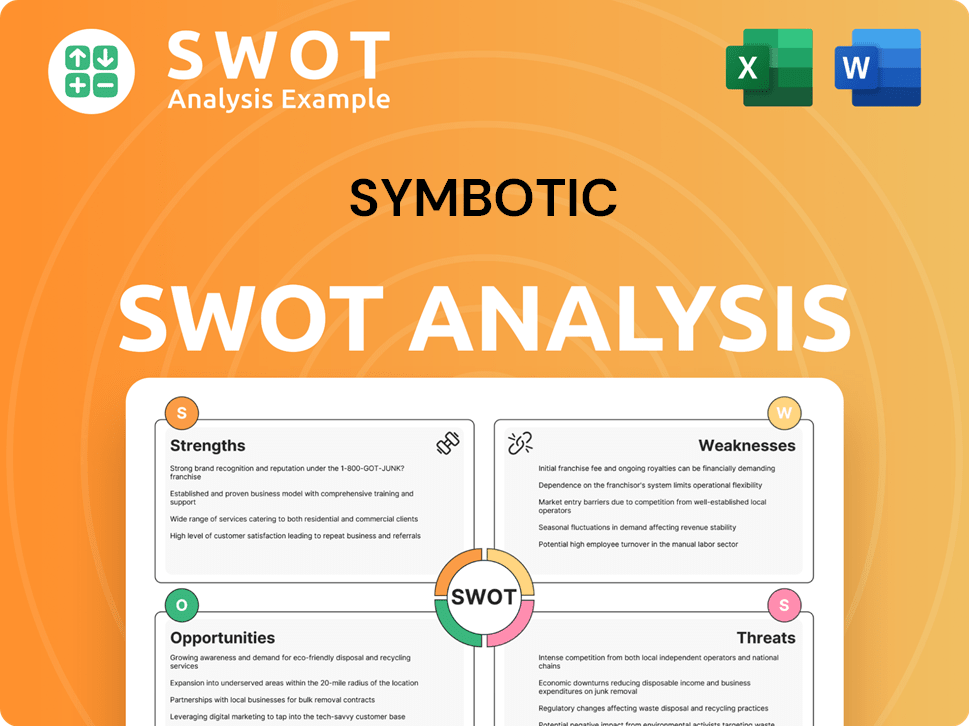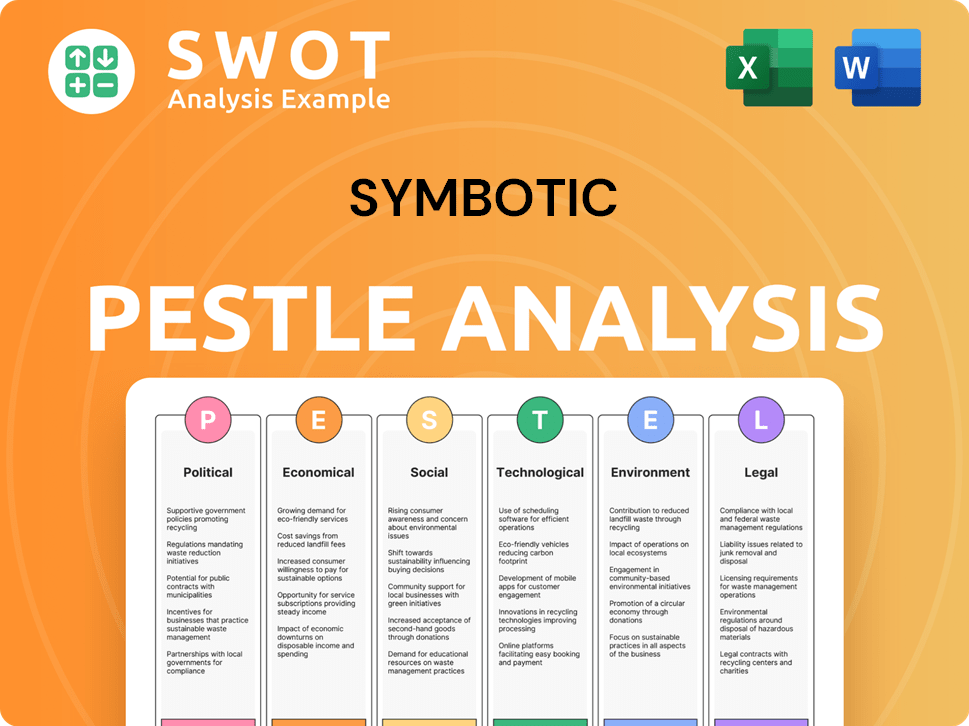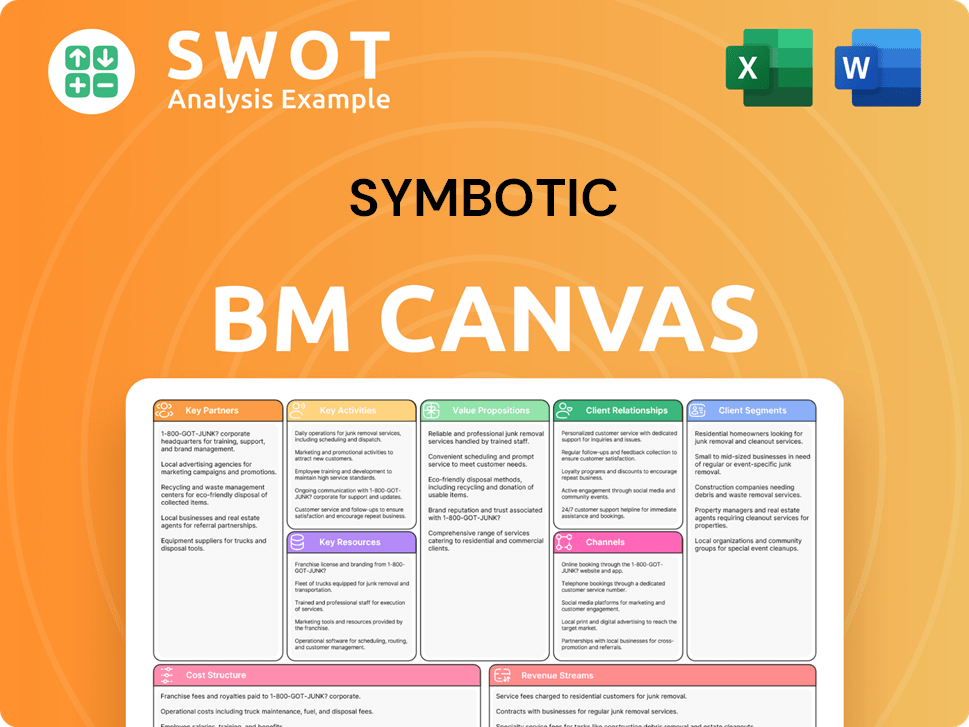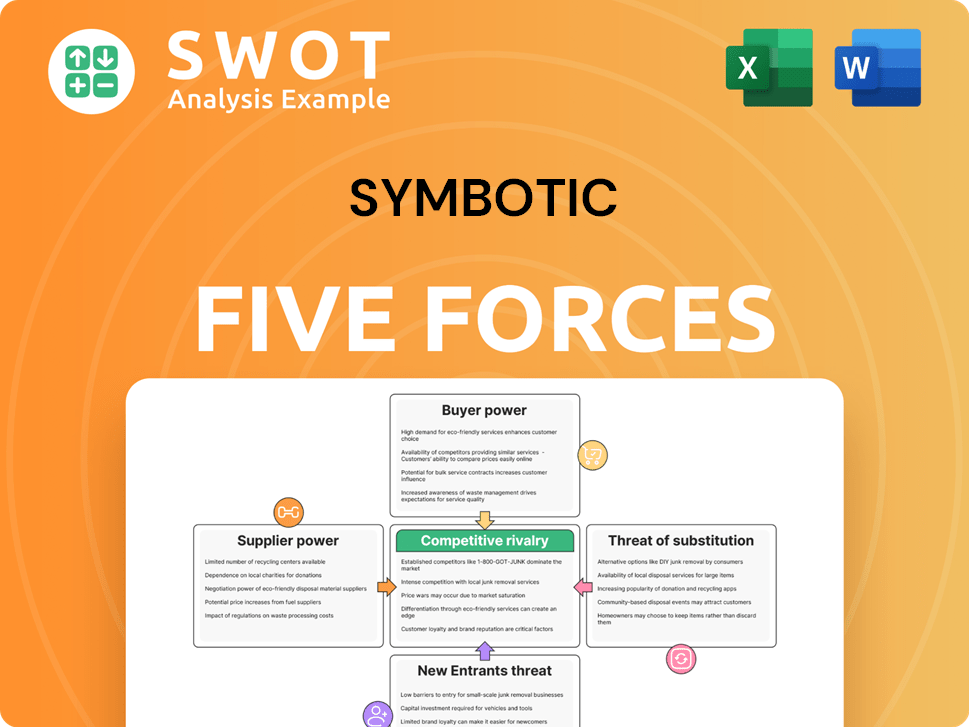Symbotic Bundle
How Does Symbotic Stack Up in the Automated Warehouse Race?
The rise of e-commerce has ignited a revolution in supply chain efficiency, making automated warehouse solutions more critical than ever. Symbotic has emerged as a key player, transforming how businesses manage inventory and logistics with its cutting-edge robotics and AI. But in this dynamic landscape, who are Symbotic's main rivals, and what sets it apart?

Understanding the Symbotic SWOT Analysis is crucial for grasping its position within the Symbotic industry. This Symbotic market analysis will explore the company's competitive advantages, examining its Symbotic competitors and dissecting its strategies for growth. We'll delve into the Symbotic competitive landscape, providing insights into its technology, customer base, and future outlook within the automated warehouse solutions and supply chain automation sectors.
Where Does Symbotic’ Stand in the Current Market?
Symbotic holds a significant position within the automated warehouse solutions market. They primarily serve large retailers, wholesalers, and food and beverage distributors. Their focus is on providing comprehensive supply chain automation solutions.
The company's core operations center around the Symbotic System. This system integrates proprietary software, mobile robots (bots), and high-density storage structures. The aim is to create highly efficient, automated warehouses for their clients. This approach helps improve throughput, reduce operational costs, and optimize space utilization.
Symbotic's value proposition lies in its ability to transform warehouse operations. They offer solutions that enhance efficiency and reduce expenses. This is particularly important for companies managing complex supply chains. For more details, you can explore the Revenue Streams & Business Model of Symbotic.
While specific market share figures for 2024-2025 are still developing, Symbotic has shown robust growth. Revenue for fiscal year 2023 reached $1.18 billion, reflecting strong market penetration. This growth indicates a solid competitive stance within the Symbotic industry.
Symbotic's customer base includes major players like Walmart, which significantly contributes to its revenue. This partnership underscores its strong standing in the retail logistics sector. The company's strategic focus is on large-scale operations requiring sophisticated automation.
Symbotic's presence is predominantly within North America, with a strong focus on the U.S. market. This geographic concentration allows for targeted strategies and efficient service delivery. This focus is a key aspect of their growth strategy.
Symbotic's financial health is demonstrated by its revenue growth and order backlog. As of late 2023, the company had an order backlog of $12 billion, highlighting sustained demand. This strong financial position supports a positive future outlook.
Symbotic maintains a strong position in the automated storage and retrieval segment. They are expanding their offerings to encompass broader aspects of warehouse automation. This strategic shift aims to provide more comprehensive supply chain solutions.
- Focus on large-scale operations.
- Emphasis on improving throughput and reducing costs.
- Expansion into broader supply chain solutions.
- Strong partnerships with major retailers.
Symbotic SWOT Analysis
- Complete SWOT Breakdown
- Fully Customizable
- Editable in Excel & Word
- Professional Formatting
- Investor-Ready Format

Who Are the Main Competitors Challenging Symbotic?
The Owners & Shareholders of Symbotic operates within a dynamic and competitive environment, facing both direct and indirect competition in the supply chain automation and automated warehouse solutions sectors. Understanding the Symbotic competitive landscape is crucial for assessing its market position and growth potential. This analysis considers key rivals, market dynamics, and the strategic factors influencing Symbotic's competitive standing.
Symbotic's main rivals include companies offering similar automated storage and retrieval systems (AS/RS) and robotics solutions for warehouses. These competitors often vie for major contracts, where system scalability, integration capabilities, and return on investment are critical. The competitive landscape is also shaped by mergers, acquisitions, and technological advancements, which continually reshape the industry and influence Symbotic's market share.
The competitive dynamics within the Symbotic industry involve battles over major client contracts, where factors like system scalability, integration capabilities, return on investment, and proven operational efficiency play crucial roles. Mergers and alliances, such as various acquisitions in the material handling sector, also continually reshape the competitive landscape, leading to larger, more diversified competitors.
Direct competitors offer similar automated storage and retrieval systems (AS/RS) and robotics solutions. These companies often compete head-to-head for large-scale distribution center projects.
Knapp AG provides integrated intralogistics solutions, including AS/RS, conveying systems, and picking technologies. It frequently competes with Symbotic for large-scale distribution center projects.
Daifuku Co., Ltd. is a global leader in material handling systems, offering a wide range of automated solutions from AS/RS to conveyors and sorting systems. It has a strong presence in various industries.
Dematic, a subsidiary of Kion Group, provides comprehensive automation solutions for warehouses and distribution centers, including AS/RS, AGVs, and software. It is a direct rival in automating large-scale logistics operations.
Indirect competitors offer alternative warehouse optimization solutions, such as traditional manual labor providers, forklift manufacturers, and software companies offering warehouse management systems (WMS) without integrated hardware.
Emerging players in the robotics and AI space, particularly those focused on last-mile delivery or specialized picking robots, also pose a potential future challenge as their technologies mature and integrate further into warehouse operations.
Symbotic's competitive advantages include its advanced robotic solutions, scalable systems, and strong partnerships, such as its collaboration with Walmart. The company's ability to offer comprehensive automation solutions is a key differentiator. The market dynamics are influenced by technological advancements, the increasing demand for e-commerce fulfillment, and the need for efficient supply chain automation.
- Scalability: Symbotic's systems are designed to scale, making them suitable for large distribution centers.
- Integration Capabilities: The ability to integrate with existing warehouse infrastructure is crucial.
- Return on Investment (ROI): Customers prioritize systems that offer a clear ROI through increased efficiency and reduced labor costs.
- Technological Advancements: Continuous innovation in robotics and AI drives the competitive landscape.
- Market Demand: The growth of e-commerce fuels the demand for automated warehouse solutions.
Symbotic PESTLE Analysis
- Covers All 6 PESTLE Categories
- No Research Needed – Save Hours of Work
- Built by Experts, Trusted by Consultants
- Instant Download, Ready to Use
- 100% Editable, Fully Customizable

What Gives Symbotic a Competitive Edge Over Its Rivals?
The competitive landscape for companies offering automated warehouse solutions is dynamic, with several key players vying for market share. Understanding the competitive advantages of companies like Symbotic is crucial for investors and industry analysts. Symbotic's success is built upon its proprietary technology and strategic partnerships within the supply chain automation sector.
Symbotic's approach involves a combination of advanced robotics, artificial intelligence, and high-density storage systems. This integrated system allows for significant efficiency gains in warehouse operations. The company's ability to deliver a complete, integrated solution, from hardware installation to software implementation and ongoing support, also sets it apart from competitors that may offer more fragmented services. A Brief History of Symbotic highlights the evolution of its technology.
The company's strategic moves and technological advancements have positioned it favorably in the market. Symbotic's competitive edge is further solidified by its strong customer relationships and long-term contracts with major retailers, which provide a stable revenue stream. The substantial order backlog, reported at $12 billion as of late 2023, underscores the demand for its solutions and the trust placed in its capabilities. The company's focus on continuous R&D and patent protection also contribute to its long-term sustainability.
Symbotic's core strength lies in its proprietary Symbotic System, which integrates advanced robotics, AI, and high-density storage. This system enables unparalleled efficiency in warehouse operations. The company's bots navigate complex warehouse environments with precision, leading to substantial labor savings and increased throughput for clients.
Symbotic has established strong customer relationships, particularly with major retailers. These long-term contracts provide a stable revenue stream and validate the effectiveness of its technology on a large scale. The partnerships demonstrate the value and reliability of Symbotic's solutions in real-world applications.
Symbotic offers a complete, integrated solution, from hardware installation to software implementation and ongoing support. This comprehensive approach differentiates it from competitors offering fragmented services. This integrated approach reduces the complexity for clients, providing a seamless experience.
The substantial order backlog, reported at $12 billion as of late 2023, highlights the strong demand for Symbotic's solutions. This backlog reflects the trust placed in the company's capabilities and its ability to deliver value to its customers. The backlog also indicates significant growth potential.
Symbotic's competitive advantages are multifaceted, stemming from its technological innovations, strategic partnerships, and comprehensive service offerings. These advantages have allowed the company to capture significant market share in the automated warehouse solutions sector. The company's focus on continuous R&D and patent protection also contribute to its long-term sustainability.
- Proprietary Technology: The Symbotic System, including advanced robotics and AI, provides superior efficiency.
- Strong Customer Relationships: Long-term contracts with major retailers like Walmart provide revenue stability.
- Integrated Solutions: Complete solutions from hardware to software implementation set it apart.
- Substantial Order Backlog: A $12 billion backlog as of late 2023 indicates strong market demand.
Symbotic Business Model Canvas
- Complete 9-Block Business Model Canvas
- Effortlessly Communicate Your Business Strategy
- Investor-Ready BMC Format
- 100% Editable and Customizable
- Clear and Structured Layout

What Industry Trends Are Reshaping Symbotic’s Competitive Landscape?
The Symbotic competitive landscape is significantly influenced by industry trends, future challenges, and potential opportunities within the automated warehouse solutions sector. This analysis focuses on the factors shaping the company's position, the risks it faces, and its future outlook. The demand for faster and more efficient order fulfillment, driven by e-commerce growth, is a key driver for companies like Symbotic, which offers advanced supply chain automation solutions.
The automated warehouse industry is experiencing rapid expansion, with a projected market size of over $30 billion by 2024. This growth is fueled by the need for improved supply chain resilience and reduced operational costs. However, the high initial capital investment and the complexity of system integration pose challenges. Understanding these dynamics is crucial for evaluating Symbotic's strategic positioning and potential for growth.
E-commerce growth and consumer demand for quick deliveries are accelerating the need for automated warehouse solutions. Rising labor costs and the focus on supply chain resilience are also driving adoption. Regulatory changes related to worker safety and environmental sustainability are further influencing investment in automation.
High initial capital investments and the complexity of integrating new systems with existing infrastructure are significant hurdles. The need for skilled personnel to operate and maintain advanced technologies also presents a challenge. Competition from new market entrants and economic downturns could impact future projects.
Expanding geographic presence, especially in emerging markets, offers significant growth potential. Developing solutions for smaller warehouses and specialized product handling could open new market segments. Strategic partnerships with logistics providers or technology companies can enhance market reach and offerings.
Symbotic's ability to increase throughput and reduce reliance on manual labor provides a strong competitive edge. The company's focus on continuous innovation and deep integration with client operations enhances resilience. Its partnership with major retailers like Walmart further solidifies its market position.
Symbotic's Symbotic market analysis reveals a strong position, but it must navigate challenges and capitalize on opportunities to sustain growth. The company's success hinges on its ability to innovate, adapt to market changes, and maintain strong client relationships. For more detailed insights into the company's strategic direction, consider reading the Growth Strategy of Symbotic.
- Expansion into new geographic markets, particularly in regions with growing e-commerce sectors.
- Development of solutions tailored to smaller warehouses and specific product handling needs.
- Strategic partnerships to enhance market reach and expand service offerings.
- Continuous innovation in robotics and AI to maintain a competitive edge.
Symbotic Porter's Five Forces Analysis
- Covers All 5 Competitive Forces in Detail
- Structured for Consultants, Students, and Founders
- 100% Editable in Microsoft Word & Excel
- Instant Digital Download – Use Immediately
- Compatible with Mac & PC – Fully Unlocked

Related Blogs
- What are Mission Vision & Core Values of Symbotic Company?
- What is Growth Strategy and Future Prospects of Symbotic Company?
- How Does Symbotic Company Work?
- What is Sales and Marketing Strategy of Symbotic Company?
- What is Brief History of Symbotic Company?
- Who Owns Symbotic Company?
- What is Customer Demographics and Target Market of Symbotic Company?
Disclaimer
All information, articles, and product details provided on this website are for general informational and educational purposes only. We do not claim any ownership over, nor do we intend to infringe upon, any trademarks, copyrights, logos, brand names, or other intellectual property mentioned or depicted on this site. Such intellectual property remains the property of its respective owners, and any references here are made solely for identification or informational purposes, without implying any affiliation, endorsement, or partnership.
We make no representations or warranties, express or implied, regarding the accuracy, completeness, or suitability of any content or products presented. Nothing on this website should be construed as legal, tax, investment, financial, medical, or other professional advice. In addition, no part of this site—including articles or product references—constitutes a solicitation, recommendation, endorsement, advertisement, or offer to buy or sell any securities, franchises, or other financial instruments, particularly in jurisdictions where such activity would be unlawful.
All content is of a general nature and may not address the specific circumstances of any individual or entity. It is not a substitute for professional advice or services. Any actions you take based on the information provided here are strictly at your own risk. You accept full responsibility for any decisions or outcomes arising from your use of this website and agree to release us from any liability in connection with your use of, or reliance upon, the content or products found herein.